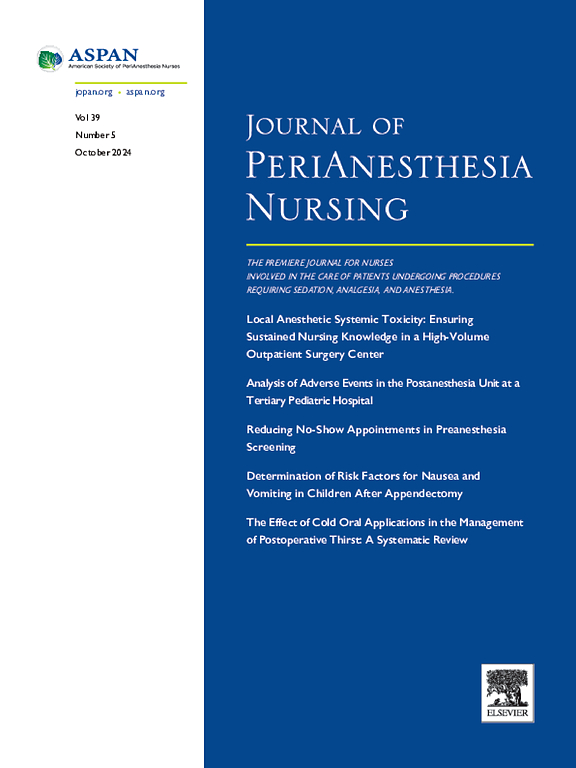在麻醉后护理病房对术后呼吸抑制高风险成人患者实施连续气管造影协议。
IF 1.6
4区 医学
Q2 NURSING
引用次数: 0
摘要
目的:该项目旨在麻醉后护理病房(PACU)为术后呼吸衰竭高危成人患者实施连续性毛细血管通气试验方案:设计: 采用干预前和干预后的质量改进设计,通过回顾性病历审查评估患者的人口统计学特征(年龄、体重、体重指数[BMI]、围手术期液体摄入量和排出量、术中呼气末正压的使用情况)、手术时间、PACU 平均住院时间、呼吸事件的发生率以及对 PACU 通气图方案的遵守情况:方法: 在 3 个月的时间内,通过回顾性病历审查收集了实施前的数据。对体重指数(BMI)大于或等于 35 kg/m2 且接受全身麻醉的当日手术患者实施了连续性毛细血管造影方案。在 3 个月的时间内收集了实施后的数据,此外还收集了患者是否遵守了毛细血管造影方案的数据。研究结果采用描述性统计方法呈现:研究结果:年龄、手术时间、体重、体重指数、围术期液体摄入量和排出量以及正压呼气末的使用均不影响 PACU 的住院时间。实施后,PACU 平均住院时间从 76.76 分钟降至 71.82 分钟,但无统计学意义(P = 0.470)。呼吸事件发生率为 6%(n = 3)。在实施了连续毛细血管造影方案后,坚持连续毛细血管造影监测的比例为 86%(n = 43):结论:术后呼吸衰竭的高危患者可能会从 PACU 的持续毛细血管造影监测中获益。与单纯的脉搏血氧仪相比,持续的毛细血管造影监测可缩短 PACU 的住院时间,并能更早地发现待处理的呼吸抑制或衰竭。本文章由计算机程序翻译,如有差异,请以英文原文为准。
Implementation of Continuous Capnography Protocol in a Postanesthesia Care Unit for Adult Patients at High-risk of Postoperative Respiratory Depression
Purpose
This project aimed to implement a continuous capnography protocol in the postanesthesia care unit (PACU) for postoperative adult patients who are at high risk for respiratory failure.
Design
A preintervention and postintervention quality improvement design with retrospective chart reviews evaluated patient demographics (age, weight, body mass index [BMI], perioperative fluid intake and output, use of intraoperative positive-end expiratory pressure), length of surgery, average length of PACU stay, incidence of respiratory events, and adherence to a PACU capnography protocol.
Methods
Preimplementation data were collected from retrospective chart reviews over a 3-month period. A continuous capnography protocol was implemented for same-day surgery patients with a BMI of 35 kg/m2 or greater and who received general anesthesia. Postimplementation data were collected over 3 months in addition to adherence to the capnography protocol. This was presented using descriptive statistics.
Findings
Age, length of surgery, weight, BMI, perioperative fluid intake and output, and use of positive-end expiratory pressure did not impact PACU length of stay. The average PACU length of stay decreased from 76.76 to 71.82 minutes postimplementation but was not statistically significant (P = .470). The incidence of respiratory events was 6% (n = 3). After the implementation of the continuous capnography protocol, adherence to the continuous capnography monitoring was 86% (n = 43).
Conclusions
Patients who are at high risk for postoperative respiratory failure may benefit from continuous capnography monitoring in the PACU. Capnography monitoring may decrease PACU length of stay and provide earlier detection of pending respiratory depression or failure than pulse oximetry alone.
求助全文
通过发布文献求助,成功后即可免费获取论文全文。
去求助
来源期刊

Journal of Perianesthesia Nursing
NURSING-
CiteScore
2.20
自引率
17.60%
发文量
279
审稿时长
90 days
期刊介绍:
The Journal of PeriAnesthesia Nursing provides original, peer-reviewed research for a primary audience that includes nurses in perianesthesia settings, including ambulatory surgery, preadmission testing, postanesthesia care (Phases I and II), extended observation, and pain management. The Journal provides a forum for sharing professional knowledge and experience relating to management, ethics, legislation, research, and other aspects of perianesthesia nursing.
 求助内容:
求助内容: 应助结果提醒方式:
应助结果提醒方式:


